Executive Summary
Branding is a crucial part of any business. It can be equated to human identity, where a person is recognized by others due to some distinct features this person possesses. Organizations and businesses spend a lot of money to ensure their brand is dominant in their respective markets. Not only does branding ensure uniformity, but it also affects consumer loyalty. The case of eBay is unique in that it has its own branding to consider and the branding of all the vendors who sell their products through the platform as well. The essay looks into eBay’s brand highlighting that the brand has been weakened by focusing too much on individual products that are owned and manufactured by the vendors on the platform.
Bad reputation has also lowered the value of eBay’s brand, which in turn has also affected the strength of the brand in the market. The essay suggests that several elements of branding have to be considered in an attempt to improve eBay’s brand. Some of the said elements are brand positioning, brand identity, brand image and also brand equity. Whereas there are many strategies that can be employed to improve the strength of eBay’s brand, it is suggested that a social media marketing strategy be used. One of the reasons for the suggestion is the fact that eBay is a purely digital platform, and social media can help boost it without spending much money. Additionally, social media is a global market, offering eBay a further reach rather than the US and a few developed countries.
Introduction
eBay is one of the world’s first e-commerce platforms. It was established in 1995 and was mainly associated with the trade of illegal or fake items (White 2012, p. 17). The multi-billion corporation was owned by Pierre Omidyar. Many people would use the platform to trade stolen items or merchandises that they could not find easily on mainstream and internet stores. However, currently, the rand has changed to a more respectable e-commerce platform for genuine business. It is important to note that the brand has, however, developed over the years.
White (2012, p. 17) argues that eBay’s brand has been affected by its negative inception. Several strategies have been put in place by management to help improve the company’s public image. Several of the strategies have proven useful. However, some have not been able to help improve the company’s brand. It is important to note at this juncture that the company’s biggest struggle has been maintaining a positive public image. Johansson and Carlson (2015, p. 12) argue that ensuring great public image in the digital space is difficult. The only way any management can assure their company’s public image is positive is through a strong brand. It can be argued that it is for this specific reason that eBay has been determined to create a dominant brand in e-commerce. Despite being one of the very first e-commerce platforms, the poor image and low brand power combined with heavy competition have ensured that eBay is not listed among the top e-commerce platforms today. The following essay analyzes eBay’s brand. Several theories and concepts will be highlighted in the attempt to determine the strength of eBay’s brand in the market. The elements that will be discussed are a description of the brand, the brand positioning, and brand analysis. Recommendations on how to make the eBay brand more dominant in the market will then be made.
The Brand
What is a Brand
Batey (2016, p. 153) defines a brand as visual and audio impressions that create a mental perception of a product, service or company. Thus, anything that reminds someone of a company or product is an element of that company’s or product’s brand. There are some critics that have argued that the concept of the brand is also attached to an emotion or feeling and does not have to be tangible material. For example, the Christmas spirit is highly associated with Coca Cola, meaning that to some extent, the company has used Christmas as part of its brand (Leibtag 2014, p. 45). Analyzing eBay’s brand, one can argue that the company uses a combination of several approaches with high importance placed on emotions. It is crucial to mention at this juncture that the current essay will only analyze the current eBay brand.
eBay’s Background Information
Market sector. eBay is categorized in the e-commerce market sector. The e-commerce sector brings together traders who offer items, both goods and services, via the online platform. Payment of services is also made online. Whereas e-commerce companies have physical offices, the offices do not stock products, and their website works by bringing traders to one reliable platform.
Major competitors. There are five major eBay competitors. These are Amazon, Bonanza, Etsy, Rakuten and eBid. All the competitors offer similar and near-similar services like eBay.
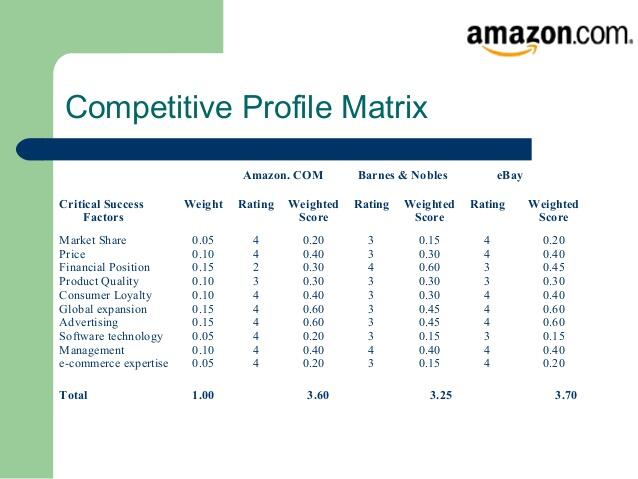
Target market. eBay’s target market is online shoppers and traders of ages 10 onwards. The target market is also global.
Brand theory. Under the brand theory, the umbrella brand, the product brand and the endorsing rand strategy will be discussed.
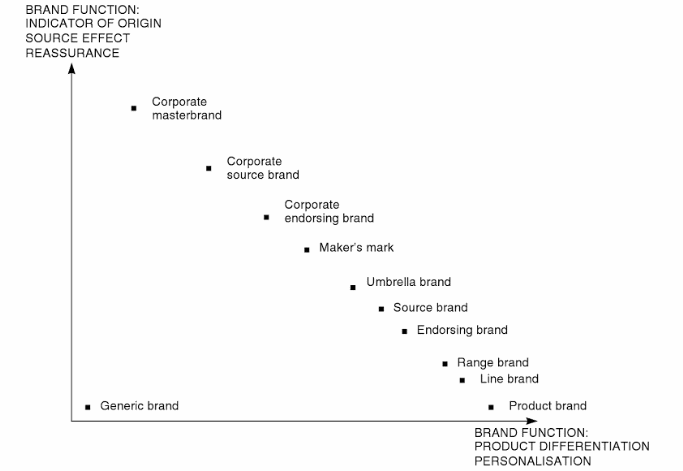
Umbrella Brand
As mentioned, eBay brings together several traders and buyers onto one platform. Thus, each of the companies that use the platform has its brand. Additionally, each of the products that the different companies sell has its own brand. The umbrella brand is that of eBay. The current eBay brand involves the use of customized shipping boxes as opposed to individual company boxes and so forth. As mentioned, the umbrella brand also relies on user emotions. For this reason, the new brand brings in a feeling of oneness despite differences. The logo has several colours indicating differences. However, the use of the different colours in one logo indicates oneness.
The Product Brand
The product brand refers to the individual products sold on eBay. One can argue that there is no way eBay can affect the product brand. Whereas this is true, the additional fact that the company has started shipping items with their own brand shows uniformity. Thus, even though the product brand might be different, the packaging is similar for all products that are purchased through eBay. On the same note, the strategy also enhances and strengthens the umbrella brand.
The Source Brand
eBay has also used the source brand to advance the umbrella brand. However, there is still much to be done. Source brand is often used to link every product developed to one brand. In the case of eBay, all products, despite their product brand, would also be branded using eBay regulations. To some extent, the use of eBay shipping packages highlights the source brand.
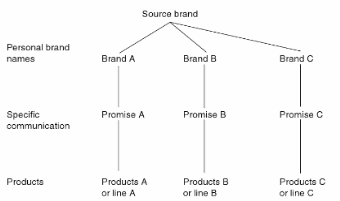
The Endorsing Brand
The endorsing brand refers to that one brand that is used in all products that are associated with a company. In the case of eBay, all products that are traded on the platform would have one endorsing the brand. In this sense, therefore, eBay’s brand endorses the rest by allowing merchants to trade on the platform. However, there are no distinct features that can be highlighted to show how eBay’s brand endorses the rest. As mentioned so far, the company has not used its own branding in the different products offered on its platform.
Brand Positioning
- What is brand positioning? According to Chernev (2015, p. 5), brand positioning is the placement of a product in the market as compared to its competitors. eBay enjoys a good brand position. The company’s largest competitor is Amazon.
- Brand positioning – Amazon. Amazon enjoys a stronger brand position compared to eBay (Hutt & Speh 2013, p. 34). One can argue that even though the two e-commerce companies have been in existence for almost the same number of years, Amazon is viewed as more legit than eBay. Secondly, Amazon has proven more innovative and creative compared to eBay, which is viewed as old.
- eBay brand positioning statement. A brand positioning statement is a guideline that directs everyone who has to use the particular product on how it is presented. Whereas eBay does not have a brand positioning statement, one can be suggested for them to fulfil the requirements of this assignment. It is recommended that eBay’s brand positioning statement be as follows: “Our brand, eBay, is positioned towards individuals above the age of 10 with access to the internet who are interested in trading in an easy, time-saving and secure platform for any high quality, genuine and legal product they are interested in, and from wherever they are around the globe”.
- Brand positioning and competitors, leading to the development of a perceptual map. Amazon’s greatest strength is the fact that people associate it with legality. As stated, eBay has been known for the purchase of illegal items. Also, Amazon took a global approach, whereas eBay is mainly associated with the US. Indeed, the fact that Amazon has more advertisement on online platforms as compared to eBay gives the first brand a better position in the market as compared to the latter brand.
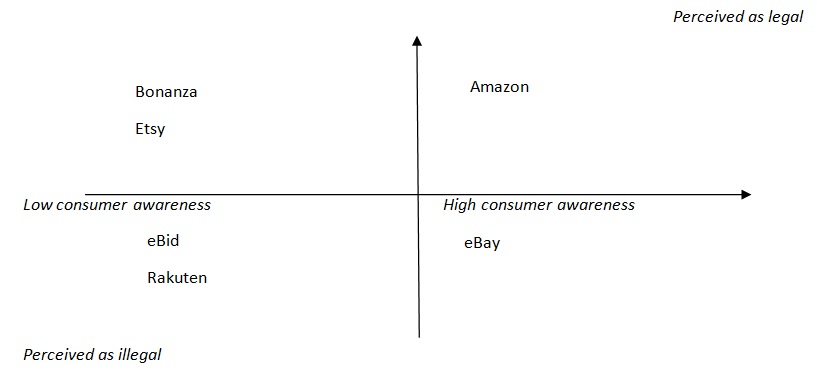
Brand Analysis
Brand Identity and Image
One can argue that brand identity and image go hand-in-hand. In fact, many times, the two are used interchangeably, albeit wrongly. According to Franzen and Moriarty (2015, p. 19), brand identity involves the emotive and mental aspects of a brand. These are the feelings and mental perceptions that a user gets when he or she sees the brand at any point. The brand image, on the other hand, is how the company wants the public to see its products. It can be argued that the vision the company has of its brand is very different from what the public sees. While analyzing eBay, one can argue that there are several components that make the brand attractive.
The first is the use of the letter ‘e’. Grammatically speaking, the word ‘eBay’ is wrong due to the fact that the first letter is small and the second letter is big. Indeed, one might initially think it is a typing error, but the word becomes very prominent wherever it is used. Secondly, the ‘e’ symbolizes the nature of the platform. As stated, eBay is an e-commerce platform. Therefore, the ‘e’ also symbolizes the ‘e-commerce’ aspect of the business.
The second aspect that makes the eBay brand prominent is the different colours used. As mentioned, the brand recently changed its logo. The current logo has green, yellow, blue and red colours. One can argue that the idea behind the branding and the logo is borrowed from Google (Liu 2015, p. 26). The different colours used to bring about a feeling of oneness despite differences. To some extent, it endorses the products offered on the platform while at the same time also creates communicates that different people can still easily access the platform from the different places they are situated. Towards this end, therefore, one can argue that the best theory for eBay’s branding is Kapferer’s brand identity prism (Kapferer 2012, p. 158). The theory suggests that users normally attach an emotion to a brand, and this, in turn, leads to brand loyalty (which will be discussed later on in the paper).
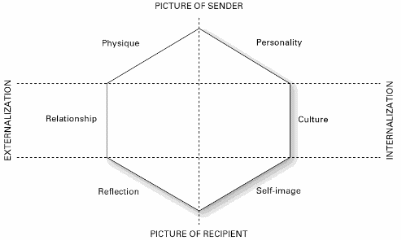
Another applicable brand identity model is De Chernatony model (Mahdi, Mobarakabadi & Hamidi, 2015, p. 115). The model suggests that a combination of the personality, positioning and vision and culture of the product will create a strong brand.
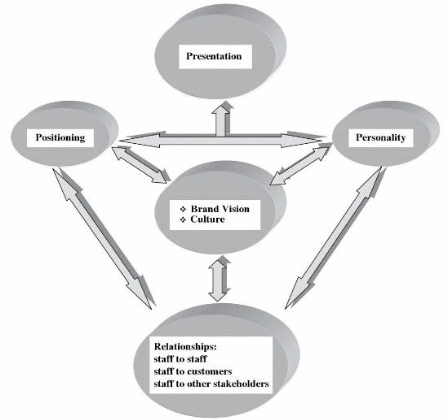
Since eBay does not have a physically strong brand, it has to come up with a strategy that ensures that users identify it as the best platform for e-commerce. There are several ways eBay can achieve this. The first is through packaging all its materials using eBay branding. Secondly, the company can use the digital advertising platform to introduce its clients to its new brand. Since a majority of its users are online, it would be easier and more effective to use digital marketing as opposed to traditional marketing only. Since the issue of legality has tarnished the brand, eBay has to completely refuse the sale of illegal items on the platform. Even though this will take the company a bit of time, it will ensure that the current public image is changed to something positive. eBay should also insist that its brand is user friendly, time-saving and safe. Safety has become a major concern in e-commerce, and eBay can use this to their advantage.
Brand Equity
Fournier, Breazeale and Avery (2015, p. 24) define brand equity as the significance of the product. There are several things that make up the value of a brand. The first element is the demand it has in the market. Some of the questions that are asked towards this end include how many sales does the product record? What position does the product hold in the market? What is the demand for the product in the market? Secondly, brand equity is also affected by stakeholder behaviour. Egger, Gula, and Walcher (2016, p. 15) argue that the different stakeholders can impact the value of a product based on their personal interests. In analyzing eBay, one can argue that there are three types of stakeholders. The first is the seller, who advertises his or her products on the website. The second stakeholder is the buyer who browsers the different categories of the products and buys what he or she desires. The third and last stakeholder is the eBay management team and employees, who work in the backend to make all the stated links.
Having said so, there are two main ways one can analyze the brand equity of eBay. The first is through the financial standing of the company. eBay is a multi-billion multinational company. According to Vulich (2014, p. 31), the company has enjoyed a 16.5% share appreciation over the last year and a mere 1.4 short position of its stock. This means that its stakeholders value the brand highly and are maintaining it to ensure profitability. The second approach to analyzing eBay’s brand equity is through consumer awareness. Already, a matrix on consumer awareness has been provided (Chart 1). It is clear from the matrix that the brand enjoys a strong consumer awareness level. However, as noted, much of the consumers that know and use eBay are in the USA. This means that the brand is not as strong in other regions as it is in the USA.
On the same note, Keller’s Brand Equity Pyramid is a viable model for analyzing eBay’s brand equity (Rossolatos 2014, p. 17). The model suggests that all elements that affect the brand should be put in the form of a hierarchy and prioritized in the same order as well. The model also focuses on the consumer as opposed to the manufacturer. The model is vale for the analysis of eBay’s brand as the company does not deal with only one manufacturer. However, a single client can use the site several times to purchase different products. Therefore, Keller’s rand Equity Pyramid will ensure that the client always gets the best service on the platform.
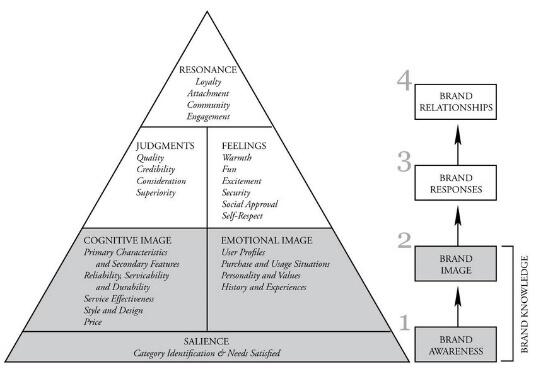
Brand Loyalty
It can be argued that all products desire to have the maximum brand loyalty possible. Kendall (2015, p. 65) explains that brand loyalty refers to the automatic choice a user makes during a purchase that allows the user to pick a familiar brand as opposed to a new one. There are several things that foster brand loyalty. First, the customer service given will determine whether a user will use the same service in the future or not. In the case of eBay, the user might have questions about the site that should be answered promptly in order to maintain a positive relationship. Indeed, it is also important to note that the specific user’s experience with a specific product can be discussed under brand loyalty. For example, endorsements that only allow eBay to sell a certain product will also translate to clients who are loyal to the specified brand shopping on eBay.
It can be argued that brand loyalty is also affected by brand personality. Kostelijk (2017, p. 13) states that shoppers normally attach a personality to the items they buy. For example, people buying Coca-Cola products are assumed to have fun and energetic personality. The same is true for eBay. It is crucial to note that a product or service can have multiple personalities. Previously, eBay was associated with older or con-people. To change this negative personality, eBay has to offer the user better experiences. This can be done by changing the look and feel of the platform so that it is more modern and user friendly (thereby tackling the age-related personality mentioned). Also, the management of eBay can revise their trade policy to ensure that the platform is safe from con-artists. It is only after doing this that the platform can attract influential people to create a personality around the brand. For example, Pepsi has used musicians such as Beyoncé to create one of their brand personalities. Thus, their clients, who admire Beyoncé, feel like the product is a common trait their share with their idol. In turn, this makes the brand very memorable, thereby encouraging the clients to be loyal.
Brand Pyramid for eBay
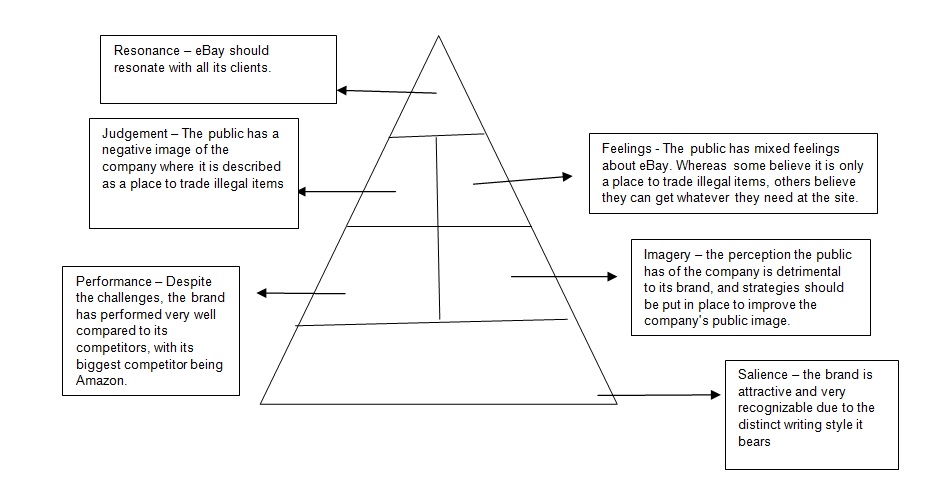
Recommendations
The first recommendation made in the development of a comprehensive communication strategy. The communication strategy holds the branding guidelines, thus, it can be engaged at all levels to clarify eBay’s branding options. It is important to note that eBay currently has a communication strategy. However, the strategy is not public. Analyzing the failing brand, one can assume that the strategy is either not implemented or does not work and has to be changed. Using the communication strategy, the company can also create the brand book. This book highlights the panties for the colours used, the use of the eBay logo on merchandise, websites and other advertising platforms and so forth.
It is crucial to point out that communication strategies also determine how people interact with the product (Percy & Rosenbaum-Elliot 2016, p. 72). For instance, examples of brand personalities have been discussed in the paper. It is the communication strategy that determines the personalities the brand should be associated with and how these personalities affect the overall performance of the product as compared to its competitors. Now that eBay has launched a new logo, the communication strategy should be used to implement the changes in all company associations. The meaning of the new logo should also be publicly explained to allow users to create personalities of their own with the brand.
It is also important to note that the company requires significant global branding. As mentioned, eBay is mainly associated with the USA. Unlike its rival, Amazon, eBay is mainly used by first world countries. Bakker (2015, p. 17) observes that the digital market is a global affair and should also include the third world countries, which carry potential clients for eBay. Today, global branding is crucial as people move easily from one place to another. The fact that e-commerce has grown into a big industry makes global branding more important. eBay has to have a strong branding for an individual in China to fully identify and prefer it over its competitors.
In addition, the ease of movement of goods and people allows companies such as eBay to have a presence in other regions. eBay has to penetrate these markets fully for financial gain. Amazon, which is eBay’s biggest competitor, has penetrated the majority of the regions carefully. eBay can manage the same through a proper global branding campaign. The campaign has to be done on a global platform at the same time in order for it to achieve the desired effect. For example, Coca-Cola has a global branding campaign dubbed “Taste the Feeling”. The campaign was not only very successful but it also encouraged new clients to buy Coca-Cola products.
The issue of packaging is very crucial for eBay. As an e-commerce platform, eBay has to also ride on the reputation of its clients. It is for this specific reason that the company has suffered negative reviews as some of its clients have been untrustworthy. Having said so, it is important for eBay to establish a singular packaging brand for all products that are traded on the platform. This means that the company should provide packaging boxes and bags to the traders. All the said materials will then be branded using the umbrella brand, which is eBay’s.
There are several advantages of brand packaging. The first advantage is that the platform will have some significant control over the merchants as the merchants have to be provided with the packaging materials. This gives eBay staff the opportunity to know which of their clients sells what, and determine whether they are legitimate. Also, brand packaging assures the buyer that the item delivered has been approved by the umbrella brand. In turn, the client trusts the umbrella brand and brand loyalty is established. It is also important to note that the brand packaging also acts as an advertisement. People that see the packaging elsewhere will immediately recognize it. In turn, the brand position in the market is strengthened.
Public image management is also very critical for eBay. In the early years of inception, the company has a challenge differentiating between genuine traders and con-artists. Even though the company had policies that tried to shift through the traders, identifying genuine products from fake ones was challenging as eBay does not stock the products. It can be argued that the new logo and brand campaign can be used to create a positive image of the company. There are several ways in which eBay can create a positive image for themselves. One, they can use endorsements by influential people to create a personality that resonates with the target group. Secondly, they can provide high quality service, in terms of user and trader support, to ensure that both trader and buyer get what they need to make their experience on the site memorably. Last but not least, they can create stronger policies, for both buyer and seller, to also ensure safety of the individual transactions done on the site.
Social Media Marketing
Having stated all this, it is recommended that a social media marketing campaign be launched to help with the globalization of the eBay brand, creation of eBay brand personalities and establishment of the public image management plan. Being a digital platform, eBay can benefit hugely from a well-designed social media campaign (McGhie 2012, p. 19). It should be noted that whereas the company has social media presence, it is still not felt on a global level as compared to its main rival, Amazon. The suggested social media campaign can help resolve this by giving options and guidelines on a definite target audience.
There are several theories that can be used in defending the idea of a social media marketing strategy to improve eBay’s brand. One such theory is the perceived theory. Percy and Rosenbaum-Elliot (2016, p. 6) explain that the perceived theory highlights the importance of trusted recommendations in marketing. Trusted recommendations are often recorded through word of mouth. Indeed, one can argue that social media is the digital word of mouth. eBay can improve its brand using both positive and negative criticism on social media. The criticism will, however, only benefit the company if the issues raised are resolved.
The social exchange theory is also very relevant in the discussion on whether eBay should have a social media marketing policy or not. According to Percy and Rosenbaum-Elliot (2016, p. 7), the social exchange theory highlights the importance of having people provide content for you. On social media, the provision of content by third parties is very common. Reviews, comments on statuses and even direct messaging all encourage clients to create content for eBay. A person who receives the wrong delivery can easily write a message to eBay on their social media platforms. eBay can then respond to the queries or issue in public. By doing so, the company will not only show accountability and reliability, but also offer other clients a chance to see what happens if they get the wrong shipment. The social exchange theory should be used carefully, however, to avoid over-indulgence with the clients.
Conclusion
In conclusion, eBay is a multi-billion e-commerce company that has been in operation since 1995. As one of the first e-commerce companies, eBay received a lot of criticism due to promoting an insecure trading platform. One of the main concerns of vendors and buyers alike was the rise of fake and illegal trades within the platform. In turn, this gave the platform a negative public image. This, coupled with the fact that eBay did not have a strong brand to begin with have led to it losing the number one position in the market, to its rival, Amazon. It can be argued that the only way for eBay to rise again is through proper branding. Some of the things that have to be considered when discussing the importance of branding to eBay’s future survival include the brand positioning, brand loyalty and brand equity. The three mentioned aspects can all improve with guidance from a structured strategy. It is recommended that eBay employs the social media marketing strategy to improve its brand. The strategy will also affect the global branding and the packaging plans that can promote the umbrella brand, which is eBay. Recently, the company unveiled a new logo that has attracted a lot of attention. The logo plays on the emotion of the user by showing a feeling of oneness despite differences. This goes hand-in-hand with what the business does; it brings together different vendors and buyers from all over the world onto one platform to trade safely.
Reference List
Bakker, D, 2015, Vertical brand portfolio management: strategies for integrated brand management between manufacturers and retailers, Springer, Germany.
Batey, M, 2016, Brand meaning: meaning, myth and mystique in today’s brands, 2nd edn, Routledge, New York, NY.
Chernev, A, 2015, Strategic brand management, Cerebellum Press, New York, NY.
Egger, R, Gula, I & Walcher, D, 2016, Open tourism: open innovation, crowdsourcing and co-creation, challenging the tourism industry. Springer- Verlag, Germany.
Fournier, S, Breazeale, M & Avery, J, 2015, Strong brands, strong relationships. Routledge, New York, NY.
Franzen, G & Moriarty, S, 2015, The science and art of branding, Routledge, London, UK.
Hutt, M D & Speh, T W, 2013, Business marketing management B2B, 11th edn, Cengage Learning, Boston, MA.
Johansson, J K & Carlson, K A, 2015, Contemporary brand management, SAGE Publications Inc, California.
Kapferer, J N, 2012, The new strategic brand management: advanced insights and strategic thinking, 5th edn, Kogan Page Limited, London, United Kingdom.
Kendall, N, 2015, What is a 21st century brand? New thinking from the next generation of advertising leaders, Kogan Page Limited, New York, NY.
Kostelijk, E, 2017, The influence of values on consumer behaviour: the value compass. Routledge, New York, NY.
Leibtag, A, 2014, The digital crown: winning at content on the web, Morgan Kaufmann, Boston, MA.
Light, L & Kiddon, J, 2015, New brand leadership: managing at the intersection of globalization, localization and personalization, Pearson Education, Pearson, NJ.
Liu, Z, 2015, ‘Made in Italy’: branding in China, Lampi di Stampa Press, India.
Mahdi, Z, Mobarakabadi, H, & Hamidi, K, 2015, ‘Brand identity and its models’, Advanced Social Humanities and Management, vol. 2, no. 4, pp. 110-116.
McGhie, A, 2012, Brand is a four letter word: positioning and the real art of marketing, Advantage, South Carolina.
Percy, L & Rosenbaum-Elliot, R H, 2016, Strategic advertising management, Oxford University Press, Oxford, UK.
Rossolatos, G, 2014, Brand equity planning with structuralist rhetorical semiotics, Kassel University Press, Zurich, Germany.
Vulich, N, 2014, Sell it online: how to make money selling on eBay, Amazon, Fiverr & Etsy, Lulu.
White, M, 2012, Buy it now: lessons from eBay, Duke University Press, London, UK.
